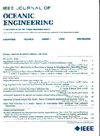高压直流海底电缆附近水运动诱发的电场
IF 5.3
2区 工程技术
Q1 ENGINEERING, CIVIL
引用次数: 0
摘要
随着对离海岸更远的互连器和海上风电场的投资增加,对高压直流(HVDC)海底电缆的许可和环境评估的需求也在增加。由于高压直流海底电缆的感应电场在以前的文献中没有被建模。在本文中,概述了一种对这种现象进行建模的方法。分析中包括电缆系统的地理位置、介质的导电性、参考系和水流剖面等因素。结果与其他出版物中采用的近似值进行了比较。给出并讨论了不同电缆系统、电缆方向和参照系下产生的电场及其空间分布。显示了局部电场对地理位置的依赖关系。研究表明,电场对海底和水中电导率变化的敏感性。具体来说,与电导率相等的情况相比,最极端的组合产生了85%的增加,这强调了介质电导率对局部电场预测的重大影响。本文概述的方法可以为未来的经验验证提供基础,并为生物学实验和许可过程提供信息。本文章由计算机程序翻译,如有差异,请以英文原文为准。
Electric Fields Induced by Water Movement in Proximity to HVDC Submarine Cables
With the raised investment in interconnectors and offshore wind farms located further from the shore, there has been an increased need for the licensing and environmental assessment of high voltage direct current (HVDC) submarine cables. The motionally induced electric fields due to HVDC submarine cables have not been previously modeled in the literature. In this article, a methodology for modeling this phenomenon is outlined. Factors, such as geographical location of the cable system, electrical conductivities of the media, reference frames, and water velocity profile, are included in the analysis. The results are compared with an approximation adopted in other publications. The resulting electric fields and their spatial distributions are presented and discussed for different cable systems, cable orientations and reference frames. The dependency of the local electric fields on the geographical location is shown. The investigation demonstrates the sensitivity of electric fields to variations in seabed and water conductivities. Specifically, the most extreme combination yielded an 85$\%$
求助全文
通过发布文献求助,成功后即可免费获取论文全文。
去求助
来源期刊

IEEE Journal of Oceanic Engineering
工程技术-工程:大洋
CiteScore
9.60
自引率
12.20%
发文量
86
审稿时长
12 months
期刊介绍:
The IEEE Journal of Oceanic Engineering (ISSN 0364-9059) is the online-only quarterly publication of the IEEE Oceanic Engineering Society (IEEE OES). The scope of the Journal is the field of interest of the IEEE OES, which encompasses all aspects of science, engineering, and technology that address research, development, and operations pertaining to all bodies of water. This includes the creation of new capabilities and technologies from concept design through prototypes, testing, and operational systems to sense, explore, understand, develop, use, and responsibly manage natural resources.
 求助内容:
求助内容: 应助结果提醒方式:
应助结果提醒方式:


